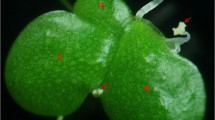Summary
Some of the hybrid seeds obtained by interspecific crosses show lack of proper development of seed parts like embryo or endosperm. If such seeds are sown, no plant is usually obtained. However, if the internal details of the seeds are known prior to sowing, embryo culture method may be resorted to for the under-developed seeds and the unfortunate loss of hybrid plants may probably be avoided. The use of X-ray photography was found to be very promising and was employed to assess the internal condition of the hybrid seeds obtained from the interspecific crossing programme, viz, 1. Oryza sativa × O. officinalis, 2. Abelmoschus esculentus × A. moschatus, 3. Lycopersicum esculentum × L. pimpinellifolium and 4. Solanum melongena × S. testiculatum. The special advantages of this technique are, that a. it is possible to know the internal development of F1 seeds without causing any damage to them; b. knowing the condition of the seed, adequate care could be provided to individual seeds as judged by the radiographs; c. it is a very quick and sure method which could be used by the geneticists and breeders in their distant crossing programmes.
Similar content being viewed by others
References
Emsweller, S. L. & Uhring, J., 1962. Endosperm-embryo incompatibility in Lilium species hybrids. Adv. hort. Sci. 2: 360–367.
Endrizzi, J. E. & Phillips, L. L., 1960. A hybrid between Gossypium arboreum and G. raimondii. Can. J. Genet. Cytol. 2: 311–319.
Feng, C. F., 1935. Genetical and cytological study of species hybrids of asiatic and American cottons. Bot. Gaz. 96: 485–504.
Gadwal, V. R., 1966. Studies on the interspecific hybridisation in the genus Abelmoschus. Diss. Ph. D., P. G. School, IARI, New Delhi.
Gopalakrishnan, R., 1958. Cytogenetical studies on interspecific hybrids in the genus Oryza. Thesis Assoc. IARI, New Delhi.
Govila, O. P. & Banerjee, S. K., 1970. X-ray screening of the F1 seeds in cotton. Indian J. Genet. (In press).
Kamra, S. K. & Simak, M., 1965. Physiological and genetical effects on seed of soft X-rays used for radiography. Bot. Notiser 118: 254–264.
Klaehn, F. U. & Wheeler, W. P., 1961. X-ray study of artificial crosses in Picea abies (L) Karst. and Picea glauca (Moench) Voss. Silvae Genet. 10: 71–77.
Lundström, A. N., 1903. Diskussionsinlagg rid For f. Skogsvard disk.-mote a Robertsfors. Arsskr. fran Foren. f. Skegavard i Norrland, Stockholm, 1904: 15.
Majid, R., 1964. Overcoming interspecific incompatibility in Lycopersicon. Curr. Sci. 33: 154–156.
Simak, M., 1957. The X-ray contrast method for seed testing: Scots pine-Pinus silvestris L Medd. f. Stat. Skogsforsk, Instt. 47: 1–22.
Simak, H. & Gustafsson, Å., 1953. X-ray photography and sensitivity in forest tree species. Hereditas 38: 458–468.
Valentine, D. H. & Woodell, S. R. J., 1963. Studies in British Primulas. X. Seed incompatibility in interspecific and intraspecific crosses at diploid and tetraploid levels. New Phytol. 62: 125–143.
Author information
Authors and Affiliations
Rights and permissions
About this article
Cite this article
Banerjee, S.K. Isolation of viable F1 seeds of some interspecific crosses by X-ray photography. Euphytica 20, 430–434 (1971). https://doi.org/10.1007/BF00035670
Issue Date:
DOI: https://doi.org/10.1007/BF00035670




